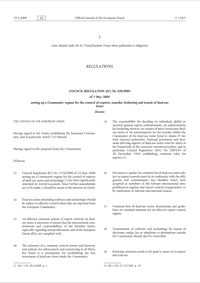
Languages: English, Bulgarian, Spanish... (23)
European Union Council Regulation (EC) No 428/2009
[Council Regulation (EC) No 428/2009]
This regulation outlines a series of export controls for dual-use items. This common control system and set of policies are intended to ensure the safe and free movement of dual-use items inside the European Union. It is the responsibility of the EU member states to give competent authorities the power to ensure that these regulations are complied with.
SUMMARY
This regulation aims to establish a European Union (EU) system for controlling the export, transfer, transportation, and brokering of dual-use items. Dual-use items are defined in the document as any goods and technology that have both a civilian and military use or any item that may assist in the manufacturing of nuclear weapons or devices. As part of this regulation, the Council establishes a common list of dual use items. These items are then subject to certain regulations within the EU and an official export authorization is required to export these items from the EU to a non-EU country. This regulation also establishes a network of competent export control authorities organized and led by the Dual-Use Coordination Group. The Dual-Use Coordination Group is tasked with exchanging information on export controls and developing tools to support implementation of aforementioned controls. The intention of this regulatory system is to ensure that the EU complies with its international obligations and agreements, especially those regarding non-proliferation.
The Council of the European Union (EU) is one of the main decision-making bodies of the European Union. The Council and the European Parliament negotiate and adopt EU laws as well as the EU budget, based on proposals generated by the European Commission. The Council also coordinates policies for EU member states, develops the EU’s foreign and security policy, and negotiates agreements between the EU and other groups. The Council of the EU has no fixed members and instead meets in 10 different configurations depending on the policy area being discussed. Configurations are composed of government ministers with expertise in the area of discussion from each of the EU member states. This regulation, like all EU legislative texts, is available in the official languages of the EU member states (excluding Irish for resource-related reasons). This act is still in force but it has been amended since its initial publication. All amendments can be found on the Council of the EU website.

..png)
